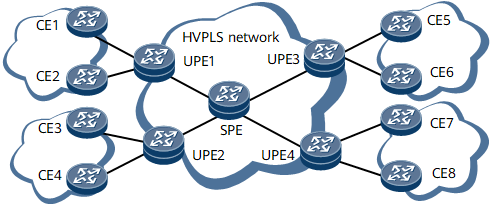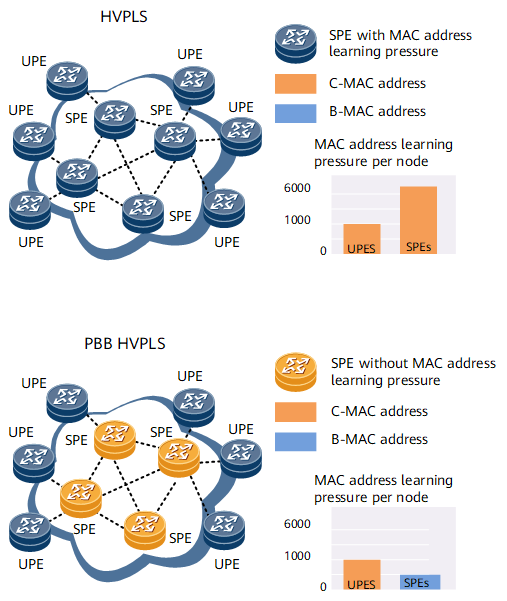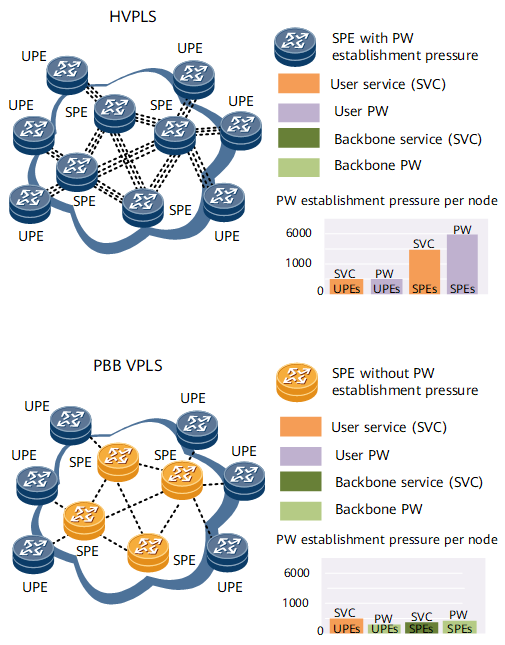Overview of PBB VPLS
Definition
Provider backbone bridge (PBB), a technique defined in IEEE 802.1ah, precedes customer MAC (C-MAC) addresses with backbone MAC (B-MAC) addresses in user packets to completely separate the user network from the carrier network. Unlike traditional Ethernet local area networks (LANs), a PBB network uses both public and user MAC addresses. This implementation ensures network stability and reduces the number of MAC entries required on public network devices. In addition, the VLAN tag field defined in IEEE 802.1Q has only 12 bits and can identify only a maximum of 4096 VLANs, which cannot meet the user requirements for sufficient tunnels. PBB, which uses instance-virtual service instances (I-VSIs) identified by 24-bit IDs, allows you to establish sufficient tunnels to transmit traffic over an Ethernet transport network.
Virtual private LAN service (VPLS) is an L2VPN technology implemented based on Multiprotocol Label Switching (MPLS) and Ethernet technologies.
PBB VPLS uses MAC-in-MAC instead of QinQ to transmit packets over a VPLS network, reducing the number of MAC entries that provider edges (PEs) must learn.
Purpose
Carriers generally use hierarchical virtual private LAN service (HVPLS) to carry metropolitan area network (MAN) services. As shown in Figure 1, by dividing the VPLS network into multiple layers, HVPLS decreases the number of required pseudo wires (PWs), reduces signaling exchange and packet replication frequency, and solves the expansibility problem confronted by full-mesh VPLS networks. HVPLS enables VPLS networks to be applied on a large scale. On the HVPLS network shown in Figure 1, user-end provider edges (UPEs) only need to learn the MAC addresses of local and remote users; superstratum provider edges (SPEs) serving as service aggregation points, however, must learn the MAC addresses of all users on the metro Ethernet. As the metro Ethernet expands in scale, SPEs have to learn increasingly more MAC addresses. Expanding the capacity of MAC forwarding tables on SPEs then becomes a challenging task.
To address the problem faced by HVPLS networks, PBB VPLS is introduced. When being used with HVPLS, PBB precedes C-SMAC addresses with B-MAC addresses in user packets and enables SPEs on the HVPLS network to transmit these packets based only on B-MAC addresses. By reducing the MAC address learning pressure of SPEs, PBB further improves the expansibility of VPLS networks.
Benefits
Flexible network expansion and reduced network costs
As shown in Figure 2, SPEs on an HVPLS network have to learn all user MAC addresses. Because the MAC address learning capabilities of SPEs are limited, you may have to add additional SPEs when expanding the HVPLS network by adding more UPEs.
PBB VPLS enables SPEs to learn only the MAC addresses of UPEs, reducing the MAC address learning pressure of SPEs. The MAC address learning pressure of SPEs does not need to be considered during the expansion of a PBB VPLS network implemented by adding more UPEs. A UPE on an HVPLS network provides access services for a maximum of 4K users, whereas a UPE on a PBB VPLS network provides access services for a maximum of 16K users. In this sense, PBB VPLS helps carriers reduce investments on UPEs.
-
After a user packet arrives at the public network, B-MAC addresses are inserted before the C-MAC addresses in the packet. This implementation shields detailed packet information and separates the user network from the carrier network, improving network security.
-
On the HVPLS network shown in Figure 3, the SPE has to establish a PW for each pair of UPEs that need to communicate, incurring high maintenance costs.
On a PBB VPLS network, packets sent by different UPEs can share the same PW. The configuration workload required to expand a PBB VPLS network is much less than that required to expand an HVPLS network.


